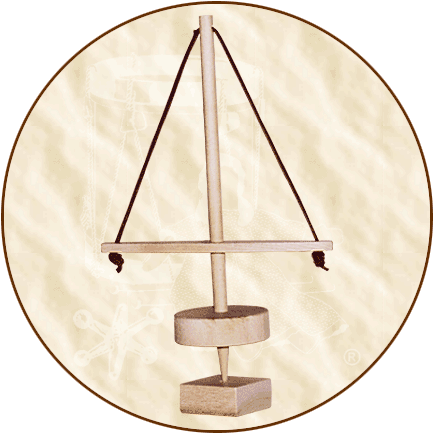.
Continued from product description on
Native American's Page Two...
Historical
Background: Perhaps one of man's earliest manufacturing
methods was the drilling of holes. Primitive objects of bone
(fish and mammal), ivory, wood, stone, and pottery have been
discovered in Native American mounds (and other burial sites),
caves, and shell heaps. The diameter of drilled holes range from
less than 1/32 of an inch to more than half an inch. The depth
of drilled holes also varied -- from less than a quarter of an
inch to more than six inches! Drilled objects have been recovered
throughout the world and date from all periods of man's existence.
Drilled holes were not necessarily crude either. Many beads
and other artifacts have been found in North America (and elsewhere)
that attest to the remarkable craftsmanship of our ancestors.
In fact, holes made by today's electric drills cannot be considered
significantly superior to those drilled over 10,000 years ago!
Graceful butterfly-shaped objects with drilled holes of amazing
accuracy have been found throughout the regions that comprise
the Eastern United States.
What is even more amazing (and much more painful to think
about) is the fact that primitive dentists were drilling holes
in teeth as far back as 9,000 years ago! Skulls of ordinary men
and women have been found with nearly perfect holes in a graveyard
in Pakistan's Baluchistan province. One skull in particular had
a hole in the inside back end of a tooth, bored out toward the
front of the month! Other skulls also had neatly drilled holes
in hard-to-reach molars.
The primitive awl is most likely the first type of drill invented
by man. This is a sharp-pointed instrument had a stone, copper
or bone point set in a socket of wood or bone. These awls were
hand-held and pressed against an object. The awl was then turned
back and forth with pressure from the arm to bore a hole. Understandably,
this method was highly laborious and likely caused hand cramps
and muscle spasms for the person drilling for long periods of
time.
Some scholars believe prehistoric man also drilled holes through
pearls by means of heated copper spindles. The drill point was
made of copper which was rolled into a cylinder of stone, shell,
wood or another piece of metal. Sometimes a piece of reed may
have been used, but we cannot be sure as no evidence has been
recovered to proof this. However, reeds could have, nevertheless,
been a viable alternative to other types of materials.
Using hollow drills to bore holes was a common practice of
early man in Asia, Africa and Europe. Evidence exists to say
that hollow drills were also used in Central and North America.
Hollow drills have been found in burial mounds in Ohio but throughout
North America solid drill points were most commonly used.
Grass and bristles have also been used for drilling. This
type of primitive drill was worked by rotating the "drill
bit" between the thumb and a finger. It is certainly debatable
which finger was used as this choice relies on personal preference
but, ergonomically speaking, it is likely the index finger was
more often used. Rubbing the thumb and index finger together
is more natural for most people.
Metal and hard stone were often chosen for drill points, but
points could also be made out of wood. To increase the boring
efficiency of wooden drills, dry or wet sand was used. Sometimes
these drill points were attached to their shafts with vegetal
fiber or strings of animal hide.
The amount of time needed to drill with a primitive drill
bit depended on the velocity of its revolution and the hardness
of the object being drilled. Of course, other factors also determined
the speed of drilling such as the size and weight of the parts
used, the depth of the desired hole or boring, and hole size
(diameter).
Drilling from both sides was also a technique used. Ample
evidence has been found to know that Native Americans saw a distinct
advantage in reducing friction by drilling an object from one
side and then the other. Artificially bored items generally indicate
exactly how the hole was made and with what type of material(s).
Besides "finger drills," there were also "shaft
drills." These basic drills were simply straight shafts
of wood or bone. The thickness of the shaft could be as little
as a quarter of an inch to over 3/4 of an inch. Drill lengths
ranged from less than 10 inches to more than two feet!
Shaft drills were rotated back and forth between the driller's
hands. A shaft drill could also be used horizontally. This was
accomplished by rolling the shaft drill up and down the thigh
with one hand and holding the object against the drill point
with the other hand.
Yet another technique was to "hold" the object between
the feet and use both hands to rotate the drill shaft back and
forth. This type of drill was seen used by members of Columbus'
expeditions and mentioned in "Antiquity of Mexico."
Along with the "strap drill," this is the only drill
mentioned by Early American explorers.
The successor to the shaft drill is the strap drill. This
tool is used not only for drilling holes but also for starting
fires. Hence, the strap drill is also known by the name "fire
drill." The shaft drill is an improvement because it increases
the number of revolutions and allows for greater pressure to
be exerted on the top of the shaft. The drill shaft is kept in
position using a piece of wood (headpiece) and held in between
the person's teeth.
The shaft is rotated by wrapping a leather strap once around
it and holding the ends by the hands. By pulling in one direction
and then the other, the shaft spun and drilled into an object.
To get a better grip, pieces of wood or bone would be attached
to the ends of the strap. The strap drill was used by cave dwellers
in France as well as the early Egyptian, Greek and Indian (Asia)
civilizations. The Aleut and Greenlanders of long ago are also
known to have used the strap drill.
The improvement to the strap drill came with the invention
of the "bow drill." This tool allowed the shaft to
be rotated at a much greater speed and the head piece is held
by a hand instead of the mouth. The strap is tied to a bowed
stick (or, possibly, a curved piece of bone) and wrapped once
around the shaft. The bow is then moved backward and forward
with the other hand to make the shaft revolve.
Scholars now believe ancient dentists probably used small
bow drills with flint drill heads between 5500 B.C. and 7000
B.C. Roberto Macchiarelli, an anthropology professor at the University
of Poitiers, France, and colleagues have simulated the technique
by drilling holes through human teeth in less than a minute!
Macchiarelli believes dentistry probably evolved from intricate
ornamental bead drilling.
Yet another improvement led to the invention of the "pump
drill." This type of drill has a shaft which passes through
a disc of stone, wood or pottery and a crosspiece through which
the shaft runs. To the ends of the crosspiece is attached a leather
string or thong, There is enough "play" in the string
or thong to allow it to cross the top of the shaft and permit
the crosspiece to reach close to the disc. The disc is turned
to wind the string about the shaft thus raising the crosspiece.
By pressing down on the crosspiece several time the shaft is
made to turn. The disc's purpose is to make the shaft rewind
the string. This method allows the pump drill to have even greater
speeds than the strap drill or bow drill. Also, one hand is left
free to hold the object being drilled.
Fun
Fact: The jar of the teeth when using a strap drill is
a disagreeable sensation that disappears with use. (And it is
not from the loss of teeth either!)
Fun
Fact: The pump drill was used by the Iroquois and Pueblo
Indians. It is still used today in the process of creating works
of art!
Not-So-Fun
Fact: The discovery of skulls with drilled teeth in Pakistan
makes dentistry 4,000 years older than first thought -- far older
than the invention of anesthesia! Ouch!













